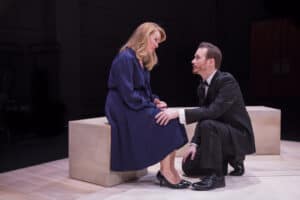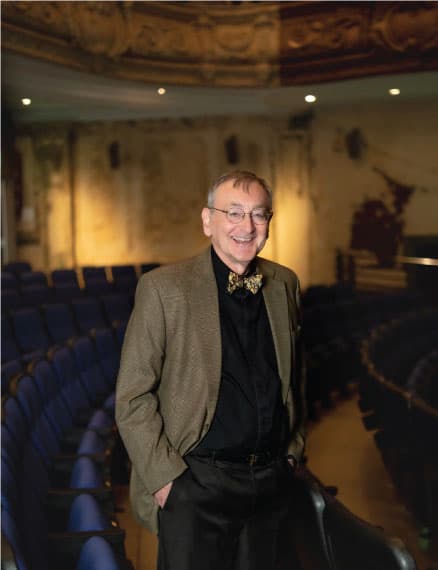A Generation and a Movement Considered in THE HEIDI CHRONICLES at The REP
Posted on BroadwayWorld September 11, 2017
The Heidi Chronicles, Wendy Wasserstein‘s Tony- and Pulitzer-winning 1988 play, returning to us courtesy of The REP Stage in Columbia, has always been hard to characterize. It’s funny, but not a comedy, and sometimes sad, but it’s not a tragedy either. This tale of a kind of upper-middle-class Everywoman making her way through much of the second half of the 20th Century is sui generis, a sort of generational case study. While I have seen it argued that the issues around feminism that the play explores still have currency, I suspect that it mainly holds our attention now as something less specific: an illustration of the interplay between a very specific set of times and a generation, and in particular the women of that generation.
These were the women who, like the protagonist Heidi Holland (Beth Hylton), were told and by and large took seriously that they had the right to succeed in all aspects and at all levels of the workplace, that sisterhood was powerful, that the personal was political, that homosexuality was as respectable as heterosexuality, and that marriage and parenthood need not be the inevitable goals of life, but if pursued, they were compatible with a career. These were also the women whose lives were battered by such things as the loss of Sixties idealism as embodied in the doomed Clean for Gene movement, the death of icons like John Lennon, the onset of the AIDS epidemic, and the moral ugliness of the Reagan administration. All of these ideas and events have their place in the play.
Finally, these were also women who, to a much greater degree than any of their predecessors, had the chance to encounter and thus fall prey to the “glittering prizes syndrome,” the impact upon your life and your integrity when you become a professional success. As Heidi Chronicles trenchantly demonstrates, you may not always want what you get, and you may a worse person if you get it and succumb to its blandishments.
Inevitably for a play thus tied to a particular time, place, and social stratum, the question may arise whether it has weathered well enough to deserve our attention nearly forty years on. Broadway audiences voted on this question with their feet when the play was revived there in 2015, starring Elisabeth Moss, scheduled for a five month run, but could not make it even two months after the official opening. One would have thought that Moss, then still finishing up the role of Peggy Olson in Mad Men (a sort of Outer-Boroughs older sister of Heidi), would have been a huge and perfect draw.
My own take, however, is that the play has aged well. Maybe it does not belong on Broadway again, but it does deserve a place in the repertoire. Women are, of course, still grappling with some of the casual sexism and some of the glittering prizes issues that Heidi confronts. But it is not the specific issues that make the play last and lead me to predict that there will be revivals a century hence. Those issues may or may not completely pass. (One thing is for sure: the pop culture time-stamps like specific songs redolent of particular years will surely almost certainly elude our grandchildren.) But the interplay between bright, somewhat idealistic people and their times is bound to continue, and stories about that interplay are bound to go on holding the attention.
This was brought home forcefully to me as the play began. Wasserstein’s biographer Julie Salamon recounts that the opening was originally to have been a scene at a 1965 high school dance, but it was pointed out that the actors who would perform it would all be in their thirties and not really convincing as high schoolers; the choice was made to flash back to that dance from an opening which introduces us to the mature Heidi, a self-confident art history professor presenting a slide lecture decrying the academy’s overlooking of female artists. In the REP’s new rendering, at least, the staging of the inserted opening did little to hold the interest, perhaps because the idea of projecting the slides onto a white floor may have seemed nifty but in practice made the pictures hard to see, perhaps because Hylton rushed the lines a little, making the lecture qua lecture hard to follow. The scene came across as the after-thought it was. It showed us only a little about Heidi and did not hold much interest as a lecture.
But when the original first scene began, and the real business of the show started, with the introduction of lifelong female pal Susan Johnston (Melissa Flaim) and of lifelong gay soul-mate Peter Patrone (Joseph W. Ritsch), things start to crackle. And they truly light up in the next scene, when Heidi three years later meets the second lifelong male connection, the amoral, seductive, but always perceptive Scoop Rosenbaum (Rex Daugherty, pictured above with Hylton). The story of Heidi and these guys, and to a lesser degree of Heidi and the women around her, a story of connected lives in a changing world, is what has lasted and will last. In a hundred years bright women will still be meeting soul mates. In a hundred years bright but vulnerable women will still be meeting men like Scoop, with similarly incandescent results. And in a hundred years men and women’s lives will still be buffeted by the prevailing winds of the time they live. The winds will be different, but the buffeting will not. And there will still be people that one knows throughout one’s life, through changing circumstances.
The male friends are of greater consequence in the play than the female ones. That may seem strange In a play usually looked upon as a feminist work, and I would regard it as a largely avoidable weakness. The bones are there in the play to make the female characters stand out more. But Susan seems more a foil than a fully-fleshed out character. And in the casting of the play, going right back to the 1989 Broadway production, which I saw (there had been an Off-Broadway avatar the previous year), there was been an surprising amount of doubling among the female performers, with each member of the supporting female cast but one (Susan) carrying at least three significant speaking roles. The original doubling patterns are precisely replicated in this production, with Hallie Cooper, Alina Collins Maldonado, and Madeline Rose Burrows doing the somewhat thankless honors. I say thankless because so much doubling tends to make the woman characters blur where they could be distinct. (A high-school production I once saw, with an unlimited supply of cast members and no doubling, made the characters easier to keep straight.) There is also one male doubler, Anderson Wells, who plays five different roles.
So this is definitely a play with three (and only three) principals. And in this production all are superb. Beth Hylton, quite familiar to Baltimore audiences, primarily for her work with Everyman, gives us a Heidi with all the highs, like the passionate embraces with Scoop, and the lows like the breakdown while giving an address to her alumni association, together with the hesitancy and the observant nature that nonetheless characteristically comes off the sidelines at some point. Joseph Ritsch, whose work in local regional and academic theater has often been in a directorial, managerial or authorial capacity, is serviceable throughout and great in communicating the pathos of Peter’s confrontation with the trauma the 1980s New York gay community went through as AIDS cut through its ranks. I have not previously seen Rex Daugherty, though he comes with a distinguished pedigree, but he is a revelation. He nails Wasserstein’s juicy lines, whether they are lustful, arrogant, or rueful, and makes us understand how this heel could nonetheless carve out such a large place in Heidi’s heart.
A last thought. I wrote above that the play is sui generis. That is not strictly true. I can’t think of anything in American theater or literature that is similar, but there are two British comparators that come to mind: Anthony Powell‘s A Dance to the Music of Time and Frederic Raphael‘s TV series The Glittering Prizes. Both works, like Heidi, follow a group of young people from an elite educational background over time without much of an overarching plot, but rather observe the evolution of the community as its members age, many of them into influential and prominent social roles. The passage of time and the individual and communal changes are the main thing. They tell us something about being a generation – not so much a particular generation as a generic one. That may sound nondescript but in practice it is a singularly valuable thing for a play to do. It is a common experience that does not receive enough dramatic attention.
And if, in the process, the play also delves thoughtfully into reminiscences of the debates over important issues like the women’s movement, as this one does, that is a terrific bonus.
Copyright (c) Jack L. B. Gohn except for production photo. Photo credit: Katie Simmons-Barth.


 I lived in London and Vienna before coming to the United States, and grew up mainly in Ann Arbor. I was writing plays and stories as early as grade school. My undergraduate years at the University of Pennsylvania, where I first reviewed theater, for the college paper, were succeeded by graduate study at the Johns Hopkins University, where I earned a doctorate in English Literature.
I lived in London and Vienna before coming to the United States, and grew up mainly in Ann Arbor. I was writing plays and stories as early as grade school. My undergraduate years at the University of Pennsylvania, where I first reviewed theater, for the college paper, were succeeded by graduate study at the Johns Hopkins University, where I earned a doctorate in English Literature.